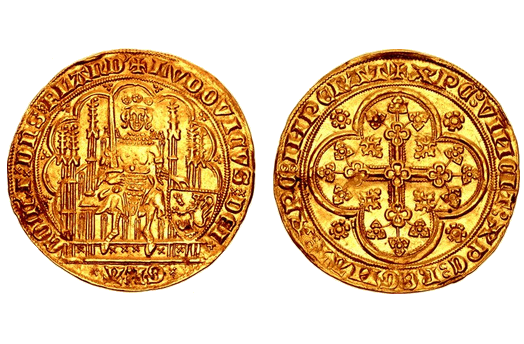
about ancient nomos
Ancient Nomos Art is a museum of galleries exhibiting ancient coins and ancient mint maps. The coin gallery displays the diverse art and history of hand-crafted ancient Greek, Roman, Byzantine, Persian and Medieval coinage. The ancient mints mapping gallery features Greek, Roman, Byzantine, Asia Minor and Medieval mint city regions and territories. Visitor's are welcome to explore, study and enjoy Ancient Nomos Art.

Medieval Flanders – 1370 AD
Lodewijk II
From Ancient Galleries

Obverse: Louis II van Male seated facing forward in Gothic throne on embellished dais; holding sword upward & resting hand on coat-of-arms.
Reverse: Large ornate cross fleurée in ornate quadrilobe; four rosettes in spandrels; double annulet legend stops.
LEGEND
Obv: + LVDOVICVS DЄI GRA COm’ (retrograde 7) DnS FLAnD’, Louis (Lodewijk) II van Male seated facing forward in Gothic throne on embellished dais with six saltaires, holding sword upward & resting hand on coat-of-arms; all within tressure of eight arcs, with trefoils in spandrels; saltire and double saltire stops. Rev: + XPC VIИCIT XPC RЄGИAT XPC IИPЄRAT, ornate cross fleurée in ornate quadrilobe; rosettes in spandrels; double annulet stops.
The gold “nieuw gouden schild” of Louis (Lodewijk) II van Male exemplify the high point of medieval Gothic coin die engraving and design. Like the great art of medieval Gothic cathedrals, Louis II coinage superbly captures the spirit of the time and raison d’être of the middle ages. This coin cleverly attempts to emulate the interiority of Gothic space, where upward soaring lines, dramatic fragile-appearing décor, intricate carvings and beautiful tracery convey the sense of being in a delicate portico interior, flanked with pinnacles and spires. This fascinating coin was issued by Louis II van Male in 1370 AD, at the height of medieval Flanders industry and at a time when he was coordinating gold coinage with that of medieval England and France, his prime trading partners. His first gouden schild was engraved and minted as a sovereign Flander simile to the House of Valois medieval gold coinage. After his first issues, Louis II’s gold coins were quickly recognized in Europe for their higher quality, large quantities and exquisitely executed Gothic design, likely engraved by the finest middle-age master artisans (see 1356 AD Goulden Lam). The elaborate gouden schild above depicts the Louis II van Male seated on an ornate Gothic style throne which stands on a dais embellished with a six saltire base. The broad chair is ornately engraved in a medieval perspective and has four delicately carved composite posts with elaborate pinnacles, fretwork, and an engrailed edged backrest. Louis II is crowned with a simple circlet heightened by four cusps, each surmounted by a large fleur-de-lis. His long hair locks fall from beneath the crown on either side. He is seen wearing the Flanders coat of mail, tabard, greaves and sabatons. He shoulders a drawn sword on his right as his left hand supports a shield edged with pellets and charged with the Flanders arms, with three fleur-de-lis, in honor of the Holy Trinity. The entire image is framed by a tressure of eight arches echoed with tracery, embellished again with a trefoil in each of the spandrels, within a denticular border, as though Louis II is seated in the nave of a glorious cathedral. In addition, the gouden schild obverse is encircled by the abbreviated Latin legend; LVDOVICVS DЄI GRA COm’ DnS FLAnD’, translated as; “Louis, King of the Flanders, by the Grace of God.” Note how the legend is cleverly arranged to accommodate the dais below. The letters are protected by a border of denticles on both sides of the legend. The coins reverse is elaborate Gothic structure design with tricorporate limbs, with each of the outer sections carefully beaded. There is an ornate quatrefoil or cross fleurée in the center, with the end of each limb terminated in a quatrefoil boss and again embellished with a beaded inner border. The cross fleurée is further embellished with fleurons (rosettes) on each cusp. There is a trefoil in each of the spandrels and, like the obverse, is again surrounded by a legend, punctuated with double annulet stops within in a concentric denticular border. The reverse is encircled by the abbreviated Latin legend; XPC VIИCIT XPC RЄGИAT XPC IИPЄRAT, translated as; “Christ victorious, Christ reigns, Christ the Lord,” which was the war cry used by the first Crusaders. This motto occurs frequently on medieval Gothic coinage, especially on the regal types.
DOCUMENTATION
Value: Nieuw gouden schild met de leeuw. Metal: AV Gold. Weight: 4.41 grams. Mint: Ghent. Date: 1370-1385 AD.
Attribution: Elsen 38; Delmonte, Or 466; De Mey, Flanders 205; Friedberg 163; Vernier 20; Gaill., 218.
Legend, Documentation and Attribution
